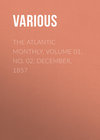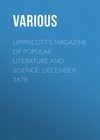Kitabı oku: «The Atlantic Monthly, Volume 01, No. 02, December, 1857»
FLORENTINE MOSAICS
[Concluded.]
VI. THE CARMINE
The only part of this ancient church which escaped destruction by fire in 1771 was, most fortunately, the famous Brancacci chapel. Here are the frescos by Masolino da Panicale, who died in the early part of the fifteenth century,—the Preaching of Saint Peter, and the Healing of the Sick. His scholar, Masaccio, (1402-1443,) continued the series, the completion of which was entrusted to Filippino Lippi, son of Fra Filippo.
No one can doubt that the hearty determination evinced by Masolino and Masaccio to deal with actual life, to grapple to their souls the visible forms of humanity, and to reproduce the types afterwards in new, vivid, breathing combinations of dignity and intelligent action, must have had an immense effect upon the course of Art. To judge by the few and somewhat injured specimens of these masters which are accessible, it is obvious that they had much more to do in forming the great schools of the fifteenth and sixteenth centuries, than a painter of such delicate, but limited genius as that of Fra Angelico could possibly have. Certainly, the courage and accuracy exhibited in the nude forms of Adam and Eve expelled from paradise, and the expressive grace in the group of Saint Paul conversing with Saint Peter in prison, where so much knowledge and power of action are combined with so much beauty, all show an immense advance over the best works of the preceding three quarters of a century.
Besides the great intrinsic merits of these paintings, the Brancacci chapel is especially interesting from the direct and unquestionable effect which it is known to have had upon younger painters. Here Raphael and Michel Angelo, in their youth, and Benvenuto Cellini passed many hours, copying and recopying what were then the first masterpieces of painting, the traces of which study are distinctly visible in their later productions; and here, too, according to Cellini, the famous punch in the nose befell Buonarotti, by which his well-known physiognomy acquired its marked peculiarity. Torregiani, painter and sculptor of secondary importance, but a bully of the first class,—a man who was in the habit of knocking about the artists whom he could not equal, and of breaking both their models and their heads,—had been accustomed to copy in the Brancacci chapel, among the rest. He had been much annoyed, according to his own account, by Michel Angelo's habit of laughing at the efforts of artists inferior in skill to himself, and had determined to punish him. One day, Buonarotti came into the chapel as usual, and whistled and sneered at a copy which Torregiani was making. The aggrieved artist, a man of large proportions, very truculent of aspect, with a loud voice and a savage frown, sprang upon his critic, and dealt him such a blow upon the nose, that the bone and cartilage yielded under his hand, according to his own account, as if they had been made of dough,—"come se fosse stato un cialdone." This was when both were very young men; but Torregiani, when relating the story many years afterwards, always congratulated himself that Buonarotti would bear the mark of the blow all his life. It may be added, that the bully met a hard fate afterwards. Having executed a statue in Spain for a grandee, he was very much outraged by receiving only thirty scudi as his reward, and accordingly smashed the statue to pieces with a sledge-hammer. In revenge, the Spaniard accused him of heresy, so that the unlucky artist was condemned to the flames by the Inquisition, and only escaped that horrible death by starving himself in prison before the execution.
VII. SANTA TRINITÀ
In the chapel of the Sassetti, in this church, is a good set of frescos by Dominic Ghirlandaio, representing passages from the life of Saint Francis. They are not so masterly as his compositions in the Santa Maria Novella. Moreover, they are badly placed, badly lighted, and badly injured. They are in a northwestern corner, where light never comes that comes to all. The dramatic power and Flemish skill in portraiture of the man are, however, very visible, even in the darkness. No painter of his century approached him in animated grouping and powerful physiognomizing. Dignified, noble, powerful, and natural, he is the exact counterpart of Fra Angelico, among the Quattrocentisti. Two great, distinct systems,—the shallow, shrinking, timid, but rapturously devotional, piously sentimental school, of which Beato Angelico was facile princeps, painfully adventuring out of the close atmosphere of the miniatori into the broader light and more gairish colors of the actual, and falling back, hesitating and distrustful; and the hardy, healthy, audacious naturalists, wreaking strong and warm human emotions upon vigorous expression and confident attitude;—these two widely separated streams of Art, remote from each other in origin, and fed by various rills, in their course through the century, were to meet in one ocean at its close. This was then the fulness of perfection, the age of Angelo and Raphael, Leonardo and Correggio.
VIII. SAN MARCO
Fra Beato Angelico, who was a brother of this Dominican house, has filled nearly the whole monastery with the works of his hand. Considering the date of his birth, 1387, and his conventual life, he was hardly less wonderful than his wonderful epoch. Here is the same convent, the same city; while instead merely of the works of Cimabue, Giotto, and Orgagna, there are masterpieces by all the painters who ever lived to study;—yet imagine the snuffy old monk who will show you about the edifice, or any of his brethren, coming out with a series of masterpieces! One might as well expect a new Savonarola, who was likewise a friar in this establishment, to preach against Pio Nono, and to get himself burned in the Piazza for his pains.
In the old chapter-house is a very large, and for the angelic Frater a very hazardous performance,—a Crucifixion. The heads here are full of feeling and feebleness, except those of Mary Mother and Mary Magdalen, which are both very touching and tender. There is, however, an absolute impotence to reproduce the actual, to deal with groups of humanity upon a liberal scale. There is his usual want of discrimination, too, in physiognomy; for if the seraphic and intellectual head of the penitent thief were transferred to the shoulders of the Saviour in exchange for his own, no one could dispute that it would be an improvement.
Up stairs is a very sweet Annunciation. The subdued, demure, somewhat astonished joy of the Virgin is poetically rendered, both in face and attitude, and the figure of the angel has much grace. A small, but beautiful composition, the Coronation of the Virgin, is perhaps the most impressive of the whole series.
Below is a series of frescos by a very second-rate artist, Poccetti. Among them is a portrait of Savonarola; but as the reformer was burned half a century before Poccetti was born, it has not even the merit of authenticity. It was from this house that Savonarola was taken to be imprisoned and executed in 1498. There seems something unsatisfactory about Savonarola. One naturally sympathizes with the bold denouncer of Alexander VI.; but there was a lack of benevolence in his head and his heart. Without that anterior depression of the sinciput, he could hardly have permitted two friends to walk into the fire in his stead, as they were about to do in the stupendous and horrible farce enacted in the Piazza Gran Duca. There was no lack of self-esteem either in the man or his head. Without it, he would scarcely have thought so highly of his rather washy scheme for reorganizing the democratic government, and so very humbly of the genius of Dante, Petrarch, and others, whose works he condemned to the flames. A fraternal regard, too, for such great artists as Fra Angelico and Fra Bartolommeo,—both members of his own convent, and the latter a personal friend,—might have prevented his organizing that famous holocaust of paintings, that wretched iconoclasm, by which he signalized his brief period of popularity and power. In weighing, gauging, and measuring such a man, one ought to remember, that if he could have had his way and carried out all his schemes, he would have abolished Borgianism certainly, and perhaps the papacy, but that he would have substituted the rhapsodical reign of a single demagogue, perpetually seeing visions and dreaming dreams for the direction of his fellow-citizens, who were all to be governed by the hallucinations of this puritan Mahomet.
IX. THE MEDICI CHAPEL
The famous cemetery of the Medici, the Sagrestia Nuova, is a ponderous and dismal toy. It is a huge mass of expensive, solemn, and insipid magnificence, erected over the carcasses of as contemptible a family as ever rioted above the earth, or rotted under it. The only man of the race, Cosmo il Vecchio, who deserves any healthy admiration, although he was the real assassin of Florentine and Italian freedom, and has thus earned the nickname of Pater Patriæ, is not buried here. The series of mighty dead begins with the infamous Cosmo, first grand duke, the contemporary of Philip II. of Spain, and his counterpart in character and crime. Then there is Ferdinando I., whose most signal achievement was not eating the poisoned pie prepared by the fair hands of Bianca Capello. There are other Ferdinandos, and other Cosmos,—all grand-ducal and pater-patrial, as Medici should be.
The chapel is a vast lump of Florentine mosaic, octagonal, a hundred feet or so in diameter, and about twice as high. The cupola has some brand-new frescos, by Benvenuto. "Anthropophagi, whose heads do grow beneath their shoulders," may enjoy these pictures upon domes. For common mortals it is not agreeable to remain very long upside down, even to contemplate masterpieces, which these certainly are not.
The walls of the chapel are all incrusted with gorgeous marbles and precious stones, from malachite, porphyry, lapis-lazuli, chalcedony, agate, to all the finer and more expensive gems which shone in Aaron's ephod. When one considers that an ear-ring or a brooch, half an inch long, of Florentine mosaic work, costs five or six dollars, and that here is a great church of the same material and workmanship as a breastpin, one may imagine it to have been somewhat expensive.
The Sagrestia Nuova was built by Michel Angelo, to hold his monuments to Lorenzo de' Medici, duke of Urbino, and grandson of Lorenzo the Magnificent, and to Julian de' Medici, son of Lorenzo Magnifico.
It is not edifying to think of the creative soul and plastic hands of Buonarotti employed in rendering worship to such creatures. This Lorenzo is chiefly known as having married Madeleine de Boulogne, and as having died, as well as his wife, of a nameless disorder, immediately after they had engendered the renowned Catharine de' Medici, whose hideous life was worthy of its corrupt and poisoned source.
Did Michel Angelo look upon his subject as a purely imaginary one? Surely he must have had some definite form before his mental vision; for although sculpture cannot, like painting, tell an elaborate story, still each figure must have a moral and a meaning, must show cause for its existence, and indicate a possible function, or the mind of the spectator is left empty and craving.
Here, at the tomb of Lorenzo, are three masterly figures. An heroic, martial, deeply contemplative figure sits in grand repose. A statesman, a sage, a patriot, a warrior, with countenance immersed in solemn thought, and head supported and partly hidden by his hand, is brooding over great recollections and mighty deeds. Was this Lorenzo, the husband of Madeleine, the father of Catharine? Certainly the mind at once dethrones him from his supremacy upon his own tomb, and substitutes an Epaminondas, a Cromwell, a Washington,—what it wills. 'Tis a godlike apparition, and need be called by no mortal name. We feel unwilling to invade the repose of that majestic reverie by vulgar invocation. The hero, nameless as he must ever remain, sits there in no questionable shape, nor can we penetrate the sanctuary of that marble soul. Till we can summon Michel, with his chisel, to add the finishing strokes to the grave, silent face of the naked figure reclining below the tomb, or to supply the lacking left hand to the colossal form of female beauty sitting upon the opposite sepulchre, we must continue to burst in ignorance. Sooner shall the ponderous marble jaws of the tomb open, that Lorenzo may come forth to claim his right to the trophy, than any admirer of human genius will doubt that the shade of some real hero was present to the mind's eye of the sculptor, when he tore these stately forms out of the enclosing rock.
A colossal hero sits, serene and solemn, upon a sepulchre. Beneath him recline two vast mourning figures, one of each sex. One longs to challenge converse with the male figure, with the unfinished Sphinx-like face, who is stretched there at his harmonious length, like an ancient river-god without his urn. There is nothing appalling or chilling in his expression, nor does he seem to mourn without hope. 'Tis a stately recumbent figure, of wonderful anatomy, without any exaggeration of muscle, and, accordingly, his name is–Twilight!
Why Twilight should grieve at the tomb of Lorenzo, grandson of Lorenzo Magnifico, any more than the grandfather would have done, does not seem very clear, even to Twilight himself, who seems, after all, in a very crepuscular state upon the subject. The mistiness is much aided by the glimmering expression of his half-finished features.
But if Twilight should be pensive at the demise of Lorenzo, is there any reason why Aurora should weep outright upon the same occasion? This Aurora, however, weeping and stately, all nobleness and all tears, is a magnificent creation, fashioned with the audacious accuracy which has been granted to few modern sculptors. The figure and face are most beautiful, and rise above all puny criticism; and as one looks upon that sublime and wailing form, that noble and nameless child of a divine genius, the flippant question dies on the lip, and we seek not to disturb that passionate and beautiful image of woman's grief by idle curiosity or useless speculation.
The monument, upon the opposite side, to Julian, third son of Lorenzo Magnifico, is of very much the same character. Here are also two mourning figures. One is a sleeping and wonderfully beautiful female shape, colossal, in a position less adapted to repose than to the display of the sculptor's power and her own perfections. This is Night. A stupendously sculptured male figure, in a reclining attitude, and exhibiting, I suppose, as much learning in his torso as does the famous figure in the Elgin marbles, strikes one as the most triumphant statue of modern times.
The figure of Julian is not agreeable. The neck, long and twisted, suggests an heroic ostrich in a Roman breastplate. The attitude, too, is ungraceful. The hero sits with his knees projecting beyond the perpendicular, so that his legs seem to be doubling under him, a position deficient in grace and dignity.
It is superfluous to say that the spectator must invent for himself the allegory which he may choose to see embodied in this stony trio. It is not enough to be told the words of the charade,—Julian, Night, Morning. One can never spell out the meaning by putting together the group with the aid of such a key. Night is Night, obviously, because she is asleep. For an equally profound reason, Day is Day, because he is not asleep; and both, looked at in this vulgar light, are creations as imaginative as Simon Snug, with his lantern, representing moonshine. If the figures should arise and walk across the chapel, changing places with the couple opposite them, as if in a sepulchral quadrille, would the allegory become more intelligible? Could not Day or Night move from Julian's monument, and take up the same position at Lorenzo's tomb, or "Ninny's tomb," or any other tomb? Was Lorenzo any more to Aurora than Julian, that she should weep for him only?
Therefore one must invent for one's self the fable of those immortal groups. Each spectator must pluck out, unaided, the heart of their mystery. Those matchless colossal forms, which the foolish chroniclers of the time have baptized Night and Morning, speak an unknown language to the crowd. They are mute as Sphinx to souls which cannot supply the music and the poetry which fell from their marble lips upon the ear of him who created them.
X. PALAZZO RICCARDI
The ancient residence of Cosmo Vecchio and his successors is a magnificent example of that vast and terrible architecture peculiar to Florence. This has always been a city, not of streets, but of fortresses. Each block is one house, but a house of the size of a citadel; while the corridors and apartments are like casemates and bastions, so gloomy and savage is their expression. Ancient Florence, the city of the twelfth and beginning of the thirteenth centuries, the Florence of the nobles, the Florence of the Ghibellines, the Florence in which nearly every house was a castle, with frowning towers hundreds of feet high, machicolated battlements, donjon keeps, oubliettes, and all other appurtenances of a feudal stronghold, exists no longer. With the expulsion of the imperial faction, and the advent of the municipal Guelphs,—that proudest, boldest, most successful, and most unreasonable bourgeoisie which ever assumed organized life,—the nobles were curtailed of all their privileges. Their city castles, too, were shorn of their towers, which were limited to just so many ells, cloth measure, by the haughty shopkeepers who had displaced the grandees. The first third of the thirteenth century—the epoch of the memorable Buondelmonti street fight which lasted thirty years—was the period in which this dreadful architecture was fixed upon Florence. Then was the time in which the chains, fastened in those huge rings which still dangle from the grim house-fronts, were stretched across the street; thus enclosing and fettering a compact mass of combatants in an iron embrace, while from the rare and narrow murder-windows in the walls, and from the beetling roofs, descended the hail of iron and stone and scalding pitch and red-hot coals to refresh the struggling throng below.
After this epoch, and with the expiration of the imperial house of the Hohenstaufen, the nobles here, as in Switzerland, sought to popularize themselves, to become municipal.
Der Adel steigt von seinen alten Burgen,
Und schwört den Städten seinen Bürger-Eid,
said the prophetic old Attinghausen, in his dying moments. The change was even more extraordinary in Florence. The expulsion of some of the patrician families was absolute. Others were allowed to participate with the plebeians in the struggle for civic honors, and for the wealth earned in commerce, manufactures, and handicraft. It became a severe and not uncommon punishment to degrade offending individuals or families into the ranks of nobility, and thus deprive them of their civil rights. Hundreds of low-born persons have, in a single day, been declared noble, and thus disfranchised. And the example of Florence was often followed by other cities.
The result was twofold upon the aristocracy. Those who municipalized themselves became more enlightened, more lettered, more refined, and, at the same time, less chivalrous and less martial than their ancestors. The characters of buccaneer, land-pirate, knight-errant could not be conveniently united with those of banker, exchange broker, dealer in dry goods, and general commission agents.
The consequence was that the fighting business became a specialty, and fell into the hands of private companies. Florence, like Venice, and other Italian republics, jobbed her wars. The work was done by the Hawkwoods, the Sforzas, the Bracciones, and other chiefs of the celebrated free companies, black bands, lance societies, who understood no other profession, but who were as accomplished in the arts of their own guild as were any of the five major and seven minor crafts into which the Florentine burgesses were divided.
This proved a bad thing for the liberties of Florence in the end. The chieftains of these military clubs, usually from the lowest ranks, with no capacity but for bloodshed, and no revenue but rapine, often ended their career by obtaining the seigniory of some petty republic, a small town, or a handful of hamlets, whose liberty they crushed with their own iron, and with the gold obtained, in exchange for their blood, from the city bankers. In the course of time such seigniories often rolled together, and assumed a menacing shape to all who valued municipal liberty. Sforza—whose peasant father threw his axe into a tree, resolving, if it fell, to join, as a common soldier, the roving band which had just invited him; if it adhered to the wood, to remain at home a laboring hind—becomes Duke of Milan, and is encouraged in his usurpation by Cosmo Vecchio, who still gives himself the airs of first-citizen of Florence.
The serpent, the well-known cognizance of the Visconti, had already coiled itself around all those fair and clustering cities which were once the Lombard republics, and had poisoned their vigorous life. The Ezzelinos, Carraras, Gonzagas, Scalas, had crushed the spirit of liberty in the neighborhood of Venice. All this had been accomplished by means of mercenary adventurers, guided only by the love of plunder; while those two luxurious and stately republics—the one an oligarchy, the other a democracy—looked on from their marble palaces, enjoying the refreshing bloodshowers in which their own golden harvests were so rapidly ripening.
Meanwhile a gigantic despotism was maturing, which was eventually to crush the power, glory, wealth, and freedom of Italy.
This palazzo of Cosmo the Elder is a good type of Florentine architecture at its ultimate epoch, just as Cosmo himself was the largest expression of the Florentine citizen in the last and over-ripe stage.
The Medici family, unheard of in the thirteenth century, obscure and plebeian in the middle of the fourteenth, and wealthy bankers and leaders of the democratic party at its close, culminated in the early part of the fifteenth in the person of Cosmo. The Pater Patriæ,—so called, because, having at last absorbed all the authority, he could afford to affect some of the benignity of a parent, and to treat his fellow-citizens, not as men, but as little children,—the Father of his Country had acquired, by means of his great fortune and large financial connections, an immense control over the destinies of Florence and Italy. But he was still a private citizen in externals. There was, at least, elevation of taste, refinement of sentiment in Cosmo's conception of a great citizen. His habits of life were elegant, but frugal. He built churches, palaces, villas. He employed all the great architects of the age. He adorned these edifices with masterpieces from the pencils and chisels of the wonderful Quattrocentisti, whose productions alone would have given Florence an immortal name in Art history. Yet he preserved a perfect simplicity of equipage and apparel. In this regard, faithful to the traditions of the republic, which his family had really changed from a democracy to a ploutarchy, he had the good taste to scorn the vulgar pomp of kings,—"the horses led, and grooms besmeared with gold,"—all the theatrical paraphernalia and plebeian tinsel "which dazzle the crowd and set them all agape"; but his expenditures were those of an intellectual and accomplished oligarch. He was worthy, in many respects, to be the chief of those haughty merchants and manufacturers, who wielded more power, through the length of their purses and the cultivation of their brains, than did all the contemporaneous and illiterate barons of the rest of Christendom, by dint of castle-storming and cattle-stealing.
In an age when other nobles were proud of being unable to write their own names, or to read them when others wrote them, the great princes and citizens of Florence protected and cultivated art, science, and letters. Every citizen received a liberal education. Poets and philosophers sat in the councils of the republic. Philosophy, metaphysics, and the restoration of ancient learning occupied the minds and diminished the revenues of its greater and inferior burghers. In this respect, the Medici, and their abetters of the fifteenth century, discharged a portion of the debt which they had incurred to humanity. They robbed Italy of her freedom, but they gave her back the philosophy of Plato. They reduced the generality of Florentine citizens, who were once omnipotent, to a nullity; but they had at least, the sense to cherish Donatello and Ghiberti, Brunelleschi and Gozzoli, Ficino and Politian.
It is singular, too, with what comparatively small means the Medici were enabled to do such great things. Cosmo, unquestionably the greatest and most successful citizen that ever lived,—for he almost rivalled Pericles in position, if not in talent, while he surpassed him in good fortune,—was, during his lifetime, the virtual sovereign of the most enlightened and wealthy and powerful republic that had existed in modern times. He built the church of San Marco, the church of San Lorenzo, the cloister of San Verdiano. On the hill of Fiesole he erected a church and a convent. At Jerusalem he built a church and a hospital for pilgrims. All this was for religion, the republic, and the world. For himself he constructed four splendid villas, at Careggi, Fiesole, Caffaggiolo, and Trebbio, and in the city the magnificent palace in the Via Larga, now called the Riccardi.
In thirty-seven years, from 1434 to 1471, he and his successors expended eight millions of francs (663,755 gold florins) in buildings and charities,—a sum which may be represented by as many, or, as some would reckon, twice as many, dollars at the present day. Nevertheless, the income of Cosmo was never more than 600,000 francs, (50,000 gold florins,) while his fortune was never thought to exceed three millions of francs, or six hundred thousand dollars. Being invested in commerce, his property yielded, and ought to have yielded, an income of twenty per cent. Nevertheless, an inventory made in 1469 showed, that, after twenty-nine years, he left to his son Pietro a fortune but just about equal in amount to that which he had himself received from his father.
With six hundred thousand dollars for his whole capital, then, Cosmo was able to play his magnificent part in the world's history; while the Duke of Milan, son of the peasant Sforza, sometimes expended more than that sum in a single year. So much difference was there between the position and requirements of an educated and opulent first-citizen, and a low-born military parvenu, whom, however, Cosmo was most earnest to encourage and to strengthen in his designs against the liberties of Lombardy.
This Riccardi palace, as Cosmo observed after his poor son Peter had become bed-ridden with the gout, was a marvellously large mansion for so small a family as one old man and one cripple. It is chiefly interesting, now, for the frescos with which Benozzo Gozzoli has adorned the chapel. The same cause which has preserved these beautiful paintings so fresh, four centuries long, has unfortunately always prevented their being seen to any advantage. The absence of light, which has kept the colors from fading, is most provoking, when one wishes to admire the works of a great master, whose productions are so rare.
Gozzoli, who lived and worked through the middle of the fifteenth century, is chiefly known by his large and graceful compositions in the Pisan Campo Santo. These masterpieces are fast crumbling into mildewed rubbish. He had as much vigor and audacity as Ghirlandaio, with more grace and freshness of invention. He has, however, nothing of his dramatic power. His genius is rather idyllic and romantic. Although some of the figures in these Medici palace frescos are thought to be family portraits, still they hardly seem very lifelike. The subjects selected are a Nativity, and an Adoration of the Magi. In the neighborhood of the window is a choir of angels singing Hosanna, full of freshness and vernal grace. The long procession of kings riding to pay their homage, "with tedious pomp and rich retinue long," has given the artist an opportunity of exhibiting more power in perspective and fore-shortening than one could expect at that epoch. There are mules and horses, caparisoned and bedizened; some led by grinning blackamoors, others ridden by showy kings, effulgent in brocade, glittering spurs, and gleaming cuirasses. Here are horsemen travelling straight towards the spectator,—there, a group, in an exactly opposite direction, is forcing its way into the picture,—while hunters with hound and horn are pursuing the stag on the neighboring hills, and idle spectators stand around, gaping and dazzled; all drawn with a free and accurate pencil, and colored with much brilliancy;—a triumphant and masterly composition, hidden in a dark corner of what has now become a great dusty building, filled with public offices.










